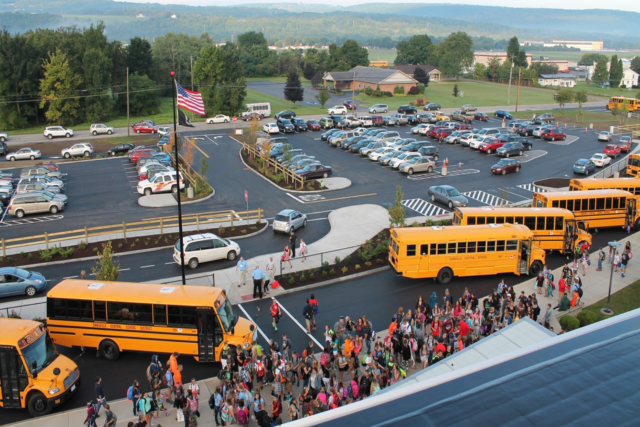School Safety Starts in the Bus Loop

In the fast-paced world that we live in, everyone always seems to be in a hurry. Whether it’s a trip to the grocery store or dropping off the kids at school prior to a work commute, time is limited and people have places to go. Couple this with commercial drivers, school bus drivers, and pedestrians, and traffic can be a stressful part of our daily routine—which is often the case on school campuses, where passenger vehicles and school buses regularly cross paths with each other during drop-off and pick-up times. With proper planning and design, however, some of these concerns can be alleviated.
Traffic flow is different at every district. Between the number of buses that need to access the site at a single drop-off time and the quantity of cars dropping off students, there’s no one-size-fits-all approach. All variables need to be evaluated to provide a customized design that allows students to safely walk into the school. Ideally, designated drop-off lanes for passenger vehicles are separated from buses as well as the school parking lots. Each bus should have a designated space in the bus loop with clear access from its door to a sidewalk, and ultimately into the school. Double stacking (parking buses where a student needs to navigate between parked buses) and areas without a defined pedestrian pathway for students provide too many instances in which an accident can occur. Additionally, passenger vehicle access should be well defined, separated from bus areas, and easy to get in and out of quickly. Often this is achieved with a designated passenger drop-off/pick-up location with space for on-campus queuing of vehicles.
Understanding the age of students also frames the layout of a site design. Younger children are frequently walked into the building, so a passenger drop-off is less crucial. In this case, short-term parking spaces close to the main entrance are the solution. As students get older and there is less of a need to walk them into the building, a passenger drop-off loop is more practical. A parent may want to watch their second grader walk into the building while a high school parent may not. Aligning a parent loop in line with the main entrance door at the elementary and middle school age becomes more important than with high schoolers.
Pedestrian routes add another layer to the design. Barriers, such as fencing and landscaping, limit the number of pedestrians crossing in front of moving vehicles. Other solutions range from providing alternate routes around drop-off areas to additional points of access based on use (teacher entrance vs. general public access). Sidewalks need to be wide enough to accommodate the volume of pedestrians and provide the most direct path to the ultimate destination.
This can be from a parking lot, a drop-off location, or from off-campus. Accessible routes from designated parking as well as drop-off loops are also incorporated into a design.
Arriving at a final plan involves not only designers, but a district’s principals, staff, transportation department, and the community. Each person accesses and uses the site differently, so it’s important to understand each viewpoint to provide a safe design that is specific to each campus. When the puzzle pieces all come together, the design is something that is efficient, easy to navigate, and safe for all users.
